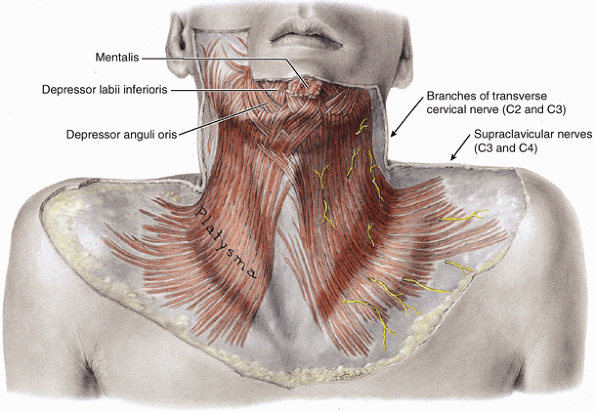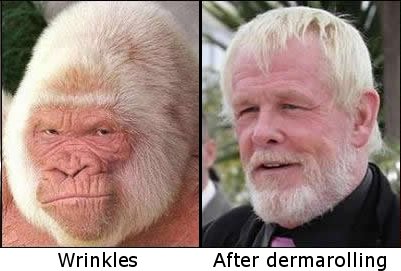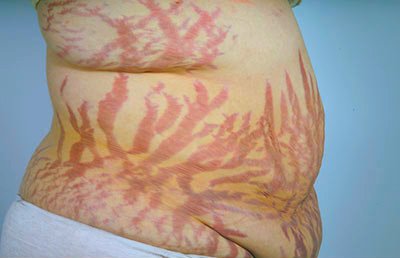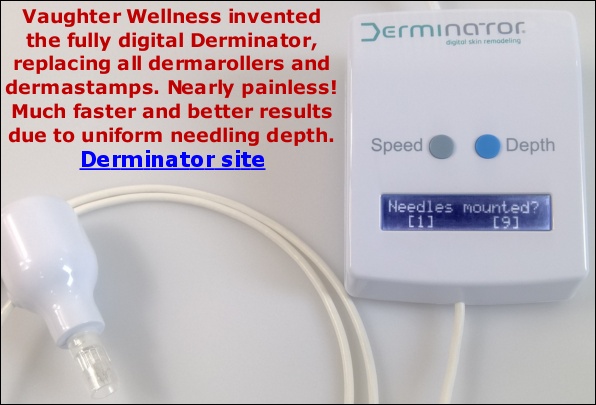Dermarolling: Hype vs. realistic results
Quite a few sites that sell dermarollers make unrealistic or downright false claims about what to expect from dermarolling. This article aims to clear up some misconceptions.
Not all crows' feet respond to dermarolling
Many of our customers reported a reduction of wrinkles and improved skin texture. From my own experience, I reduced the wrinkles between my eyebrows (11's) with single needling and on my forehead and around the lips (this area was really painful to roll) with dermarollers. The wrinkles are still visible but they filled in noticeably. Unfortunately, my crows' feet are not responding to dermarolling. Perhaps due to the fact that they are constantly reinforced by muscle activity by smiling (I do not use Botox). Do not expect that all your wrinkles will respond the same way to dermarolling.
The advantage of wrinkles being filled in by the collagen production triggered with dermarolling or needling is that the results are really long-lasting compared to injected fillers. Restylan, Perlane or other fillers based on cross-linked hyaluronic acid are very expensive and they are relatively quickly metabolized by the body, so they have to be re-injected every few months. The results of dermarolling, a cheap method, will last for years, although they are not "permanent" because a dermaroller can't stop aging and the wrinkles will eventually start to re-form. Dermarolling maintenance is necessary.
You should know that a dermaroller and other microneedling instruments such as dermastamp or the single needle can only affect the skin itself and not the underlying structures (fat, muscles etc). For this reason, they cannot for example improve "hollowness" under the eyes caused by fat recession (as we age, the subcutaneous fat recedes), neither it can significantly improve the nasolabial fold because it is not a wrinkle but a fold caused by a drop of the facial structures. Long-term dermarolling thickens the skin, fills up wrinkles, lines and scars but it has a limited effect on the nasolabial fold.
Dermarolling can't fully remove stretch marks
Don't believe claims that it can. Neither can any laser-based device. Stretch marks are deep scars in the dermis and there is currently no method that can remove them. Dermarolling or needling can very significantly improve the appearance of stretch marks but it cannot make them disappear. What you can expect after many months of dermarolling and needling of stretch marks:
- improved texture
- improved color - the color blends much more with the surrounding skin
- slightly less indentation and/or width
- tiny areas of normal skin appear in the stretch mark (islets of normal skin)
Especially when dermarolling is combined with single needling, you can expect a combination of at least a few of the above.
I am often asked whether needling can gradually replace scar tissue with normal tissue, e.g. when done monthly, for years. My honest answer is that needling scars is a new method that has not been around long enough to know the answer. So far, none of our customers achieved a complete resolution of their stretch marks. Also not of surgical scars, nor scars that resulted from serious injury. A couple of customers said that some of their smallest, shallowest stretch marks had disappeared (initially, the stretch mark broke up and became fragmented and the fragments gradually disappeared after more needling). The most common feedback is that their stretch marks improved but have not vanished; not even after one and half year of monthly needling. Since scars are merely a cosmetic issue, our body does not bother to replace scar tissue with normal skin. Skin microinjuries (which is what needling or dermarolling does) are a clever trick to force the skin into remodeling and regeneration. The microinjuries are not big enough to cause more scar tissue but they are big enough to trigger healing processes and regeneration. Unfortunately, the induced regeneration doesn't completely replace scar tissue by normal skin; it normalizes the skin only partially.
Whether partial normalization of scar tissue is the terminal point of microneedling or whether the scar tissue will gradually be replaced by normal skin until the scar is gone is still unknown. Until we know, it is unethical to advertize a dermaroller for stretch mark removal. Nonetheless, any improvement of a stretch mark or scar is a victory. Until very recently, there was no method able to achieve even a noticeable improvement.
It may be possible, but it is also still unknown whether or not dermarolling can partially prevent stretch mark formation in pregnancy.
Dermarolling can more-or-less reverse skin aging
The skin consists of two main layers. The epidermis and the dermis.
The epidermal cells turn over quick. The epidermal cells are constantly being produced at the bottom of epidermis, and then they travel up and are eventually sloughed off from the skin's surface. It takes about twenty days for the cells to get from the bottom of the epidermis to the skin surface where they are sloughed off. This continuous process slows down as we age but it is still extremely rapid, compared to the turnover of the dermis.
The dermis has an extremely slow turnover. The half-life of dermal collagen is about fifteen years!
What does this mean:
You are born with a certain amount collagen in the dermis.
- When you are 15 years old, 50% of the original collagen remains (the rest has been replaced).
- When you are 30 years old, 25% of the original collagen is still in your skin.
- When you are 45 years old, 12.5% of the original collagen is still in your skin.
- When you are 60 years old, 6.25% of the original collagen is still in your skin.
And again, the newly formed collagen has a half-life turnover of about 15 years.
When you are for example 60 years old, some of the original collagen you had as a newborn is still in your skin. This collagen has been subjected to sun damage and other damage for 60 years. It is no wonder we get wrinkles and sun-damaged skin! Elastin has an even longer half-life turnover. It is about 70 years. Sigh.
When collagen gets damaged, the body immediately repairs it but unfortunately, as we age, the repairs turn out rather provisory and to make matters worse - we're faced with diminishing collagen levels.
This extremely slow turnover of the collagen and elastin in the dermis is the reason why a tattoo in the deep dermis (>1 mm) lasts a lifetime. A Tattoo will slightly lighten over the years but its pigment weathers the decades. "Permanent" makeup is not inserted that deep so it doesn't last as long as a tattoo.
The big deal with dermarolling is that you can trick the body to trigger collagen and elastin much sooner than the natural rate of turnover.
Dermarolling with needles that reach the dermis causes tiny microinjuries in it and the body sees it as a high priority to fix them. These microinjuries will trigger new collagen. But sadly, the skin will never be as perfect as when you were young.
Ablative methods, such as acid peels or ablative lasers can't be used to reach the dermis due to the risk of scarring and hypopigmentation. But a dermaroller very easily can go that deep, because it does not ablate the skin, it only pricks it. Since the pricks are surrounded by untreated skin, the regeneration happens very quickly. It takes long to achieve results because every time you roll, you only prick small fractions of the skin. Be patient and repeat the microneedling procedure on yourself as often and as long as it takes.
Dermarolling will speed up the dermal proteins (collagen and elastin) in the dermis and this can slow down (but not stop) the signs of skin aging. Maybe not all signs but at least some.
Dermarolling and hyperpigmentation, melasma
Usually, hyperpigmentation is the result of locally uneven/excessive melanin production. Melanin is the pigment that determines the color of our skin. When our skin is exposed to the sun, it produces more melanin as a natural protection - melanin absorbs UV. Unfortunately, melanin is not always produced totally evenly, especially in individuals with darker skin.
Uneven/excessive melanin production can also be the result of skin trauma - sun burns, acne, cuts, bug bites etc. If the hyperpigmentation resides in the epidermis, it responds very well to dermarolling. If it is in the dermis (deeper part of the skin), it also responds but it takes much longer. Hyperpigmentation in the dermis is too deep for acid peels but not too deep for a dermaroller. You have to avoid excessive sun exposure and always use a sunscreen. Ignoring this advice may lead to a reappearance of the pigmentation.
Using a dermaroller to facilitate the skin penetration of skin whitening creams can be a very successful treatment for persistent or deep hyperpigmentation or melasma but you have to be careful with hydroquinone (a common skin whitening agent). The long-term usage of a high percentage of hydroquinone in combination with sun exposure can cause dark pigmentation. Do not apply high concentrations for a very long time.
I hesitate to recommend a dermaroller for melasma. Dermarolling triggers inflammation and inflammation or any kind of skin irritation can in principle worsen melasma. For the same reason, a dermaroller should not be used on Rosacea. Always do a test patch first if you use a dermaroller for melasma.
Dermarolling works against hypopigmentation
Treating hypopigmentation with dermaroller and needling showed very good results. Hypopigmented skin has malfunctioning or absent melanocytes (melanin producing cells). Skin needling triggers melanocytes production and enables migration of melanocytes from the surrounding skin into the hypopigmented area.
Dermarolling acne scars - patience rewarded
If you got what it takes - the patience and perseverance for long-term dermarolling, dermastamping and single needling - you are destined for success. Major improvement of acne scars was the most common feedback we have received.
Some of our customers combined dermarolling with other methods such as saline injections or the suction method. Both methods are explained on our forum.
Dermarolling to reduce pore size - not really
Not many customers were successful in reducing the pore size. Pores are not scars, pores are ducts in the skin and there is currently no method that can reliably and permanently reduce them. Dermarolling however often helped normalize acne prone skin and post-acne pigmentations.
Dermarolling sun-damaged skin works well
You can expect excellent results in renewing the sun-damaged skin of the face, décolleté and to a lesser extent of the forearms and the back of the hands. Application of Tretinoin (Retinoic acid or A-Ret) further boosts improvement.
Needling sagged skin - works but no miracles
Dermarolling can improve mild skin laxity and crêpey skin on the face, neck and body or a wrinkly post-pregnancy abdomen, provided there is not too much excessive skin. The bulging, sagging abdomen after pregnancy is often due to the abdominal muscles not having gone fully back to their original position - this can only be fixed by a tummy tuck.
You can greatly improve a tummy tuck scar or a C-section scar by needling. The scar will soften and becomes less visible. Dermarolling cannot get rid of excessive skin after major weight loss. Skin folds can only be fixed by plastic surgery.
In the process of aging, the face and the neck start to "hang" due to:
- loosening of ligaments that attach the skin to the bones
- gravity
- loss of fat and descending of fat
- loss of elasticity.
Dermarolling can improve mild skin laxity but it cannot fix severely "hanging" skin.
The situation is even more complex on the neck. There is a muscle running from the collarbones to the jaw (Platysma muscle). This thin muscle holds the subcutaneous fat and everything else tightly in. When fat deposits accumulate in the platysma muscle area, we end up with a double chin. As we age, the platysma muscle slightly falls which causes jowls and a hanging neck. In addition, the muscle often starts separating in the midline of the neck, which allows fat protrusion that further contributes to a sagging neck.

Dermarolling cannot fix the problems related to the platysma muscle - it can only improve skin texture mild skin laxity of the neck.
Wild claims to sell more rollers
Some websites say that dermarolling reverses gray hair, completely removes cellulite, helps with slimming, enhances breast size and so on. It's all nonsense, as we showed in this posting, where we found falsified before-and-after pictures: Dermarolling breast enlargement scam.






















